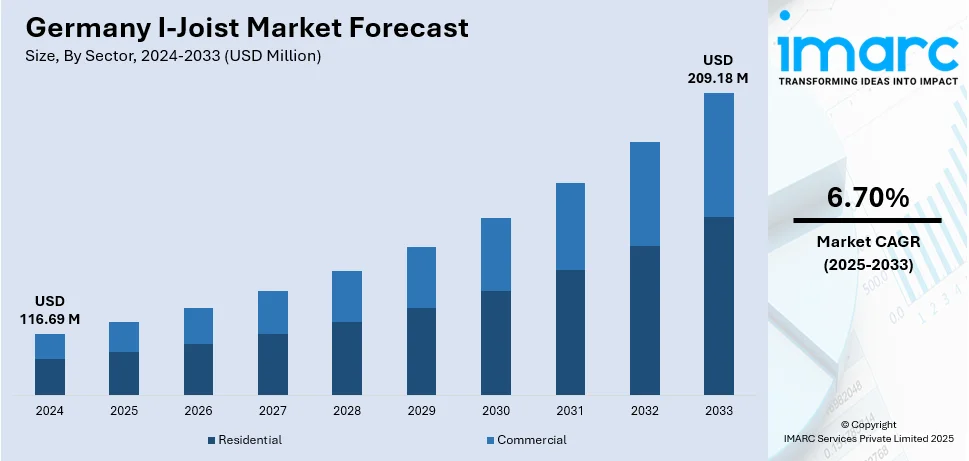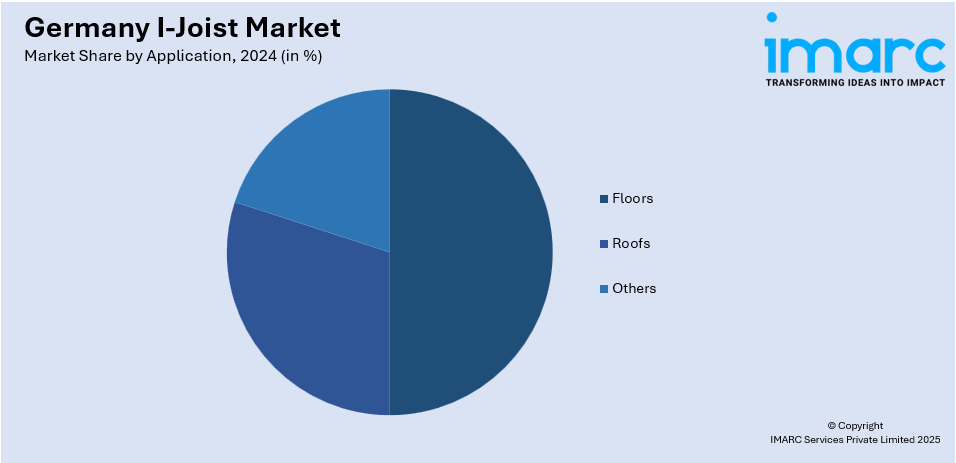
Germany I-Joist Market Size, Share, Trends and Forecast by Sector, New Construction and Replacement, Application, and Region, 2025-2033
Germany I-Joist Market Overview:
The Germany I-joist market size reached USD 116.69 Million in 2024. Looking forward, IMARC Group expects the market to reach USD 209.18 Million by 2033, exhibiting a growth rate (CAGR) of 6.70% during 2025-2033. The increasing demand for sustainable and lightweight construction materials, growth in residential and commercial building projects, strict environmental regulations, with advancements in engineered wood technology and rising adoption of prefabricated structures are further fostering the expansion of Germany I-joist market share.
|
Report Attribute
|
Key Statistics
|
|---|---|
|
Base Year
|
2024 |
|
Forecast Years
|
2025-2033
|
|
Historical Years
|
2019-2024
|
| Market Size in 2024 | USD 116.69 Million |
| Market Forecast in 2033 | USD 209.18 Million |
| Market Growth Rate 2025-2033 | 6.70% |
Germany I-Joist Market Trends:
Sustainability and eco-friendly construction:
The increasing focus on sustainability in the construction sector has significantly influenced the Germany I-joist market growth. For instance, in a report published on September 30, 2024, the European Environment Agency (EEA) noted that buildings are responsible for more than 30% of the environmental impact of the EU, 42% of overall energy use, and 35% of greenhouse gas emissions. The study highlights the need for sustainability of Europe's housing market may be greatly improved by clever renovations that use sustainable materials. In order to promote biodiversity and strengthen climate resilience, it also promotes the incorporation of green areas and flora into architectural designs. They have become a more popular option owing to their efficiency and smaller environmental impact, especially as environmental regulations become stricter and consumer preferences shift toward eco-friendly building materials. It is made primarily from engineered wood products and has a high strength-to-weight ratio, which allows for the use of less material compared to traditional lumber. This conserves resources and leads to lower greenhouse gas (GHG) emissions during production and transportation. Additionally, many manufacturers are adopting sustainable practices, such as sourcing timber from certified forests and employing environmentally friendly adhesives, enhancing the appeal of I-joists in green building projects, which is further bolstering the market growth.

Changing construction practices:
The shifting trend toward lightweight and prefabricated building methods is acting as another growth-inducing factor. For instance, on February 24, 2025, an article was published about a modular home built in Jerbourg by Baufritz, a German business that has been building prefabricated homes for more than a century. Including shipping costs, the entire project cost about 30% less than usual construction methods, and the seven-bedroom, four-story villa was put together in just ten days. I-joists, known for their lightweight nature, facilitate easier handling and quicker assembly on job sites, making them ideal for modern construction techniques. This shift is particularly prominent in the residential construction sector, where builders are increasingly adopting prefabricated components to reduce construction time and labor costs. The flexibility of I-joists in terms of design and application aligns well with the growing trend of open floor plans and spacious interiors, allowing architects and builders to create innovative designs without compromising structural integrity. I-joists compatibility with contemporary building methods that prioritize efficiency, and flexibility, which in turn is positively impacting the Germany I-joist market outlook.
Germany I-Joist Market Segmentation:
IMARC Group provides an analysis of the key trends in each segment of the market, along with forecasts at the country level for 2025-2033. Our report has categorized the market based on sector, new construction and replacement, and application.
Sector Insights:
- Residential
- Commercial
The report has provided a detailed breakup and analysis of the market based on the sector. This includes residential and commercial.
New Construction and Replacement Insights:
- New construction
- Replacement
A detailed breakup and analysis of the market based on the new construction and replacement have also been provided in the report. This includes new construction and replacement.
Application Insights:

- Floors
- Roofs
- Others
The report has provided a detailed breakup and analysis of the market based on the application. This includes floors, roofs, and others.
Regional Insights:
- Western Germany
- Southern Germany
- Eastern Germany
- Northern Germany
The report has also provided a comprehensive analysis of all the major regional markets, which include Western Germany, Southern Germany, Eastern Germany, and Northern Germany.
Competitive Landscape:
- The market research report has also provided a comprehensive analysis of the competitive landscape. Competitive analysis such as market structure, key player positioning, top winning strategies, competitive dashboard, and company evaluation quadrant has been covered in the report. Also, detailed profiles of all major companies have been provided.
Germany I-Joist Market Report Coverage:
| Report Features | Details |
|---|---|
| Base Year of the Analysis | 2024 |
| Historical Period | 2019-2024 |
| Forecast Period | 2025-2033 |
| Units | Million USD |
| Scope of the Report | Exploration of Historical Trends and Market Outlook, Industry Catalysts and Challenges, Segment-Wise Historical and Future Market Assessment:
|
| Sectors Covered | Residential, commercial |
| New Construction and Replacements Covered | New Construction, Replacement |
| Applications Covered | Floors, Roofs, Others |
| Regions Covered | Western Germany, Southern Germany, Eastern Germany, Northern Germany |
| Customization Scope | 10% Free Customization |
| Post-Sale Analyst Support | 10-12 Weeks |
| Delivery Format | PDF and Excel through Email (We can also provide the editable version of the report in PPT/Word format on special request) |
Key Benefits for Stakeholders:
- IMARC’s industry report offers a comprehensive quantitative analysis of various market segments, historical and current market trends, market forecasts, and dynamics of the Germany I-joist market from 2019-2033.
- The research report provides the latest information on the market drivers, challenges, and opportunities in the Germany I-joist market.
- Porter's five forces analysis assist stakeholders in assessing the impact of new entrants, competitive rivalry, supplier power, buyer power, and the threat of substitution. It helps stakeholders to analyze the level of competition within the Germany I-joist industry and its attractiveness.
- Competitive landscape allows stakeholders to understand their competitive environment and provides an insight into the current positions of key players in the market.
Key Questions Answered in This Report
The I-Joist market in Germany was valued at USD 116.69 Million in 2024.
The Germany I-Joist market is projected to exhibit a CAGR of 6.70% during 2025-2033, reaching a value of USD 209.18 Million by 2033.
Germany’s I-Joist market is driven by growing demand for sustainable and engineered wood solutions, increased construction and renovation activities, and preference for lightweight yet durable building materials. Supportive building regulations, focus on energy-efficient structures, and advancements in production technologies further enhance the adoption of I-Joists across residential and commercial projects.
Need more help?
- Speak to our experienced analysts for insights on the current market scenarios.
- Include additional segments and countries to customize the report as per your requirement.
- Gain an unparalleled competitive advantage in your domain by understanding how to utilize the report and positively impacting your operations and revenue.
- For further assistance, please connect with our analysts.
 Request Customization
Request Customization
 Speak to an Analyst
Speak to an Analyst
 Request Brochure
Request Brochure
 Inquire Before Buying
Inquire Before Buying




.webp)




.webp)












